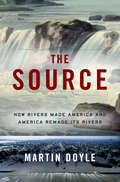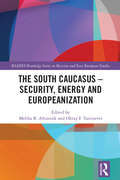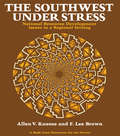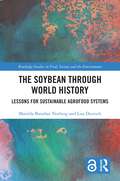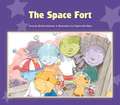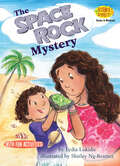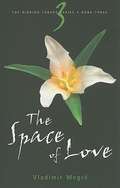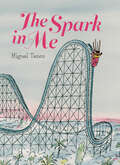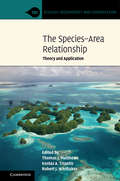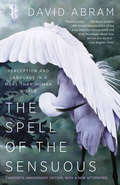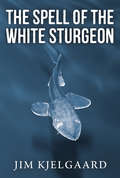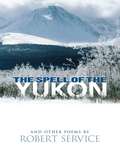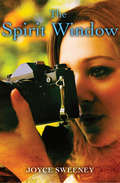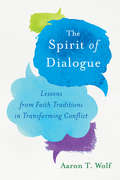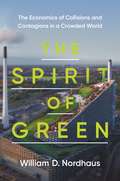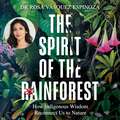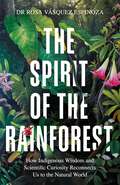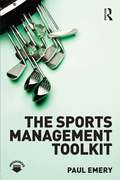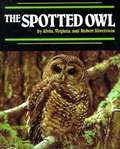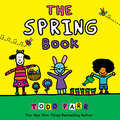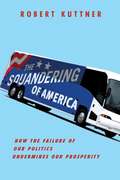- Table View
- List View
The Source: How Rivers Made America And America Remade Its Rivers
by Martin DoyleHow rivers have shaped American politics, economics, and society from the beginnings of the Republic to today. America has more than 250,000 rivers, coursing over more than 3 million miles, connecting the disparate regions of the United States. On a map they can look like the veins, arteries, and capillaries of a continent-wide circulatory system, and in a way they are. Over the course of this nation’s history rivers have served as integral trade routes, borders, passageways, sewers, and sinks. Over the years, based on our shifting needs and values, we have harnessed their power with waterwheels and dams, straightened them for ships, drained them with irrigation canals, set them on fire, and even attempted to restore them. In this fresh and powerful work of environmental history, Martin Doyle tells the epic story of America and its rivers, from the U.S. Constitution’s roots in interstate river navigation, the origins of the Army Corps of Engineers, the discovery of gold in 1848, and the construction of the Hoover Dam and the TVA during the New Deal, to the failure of the levees in Hurricane Katrina and the water wars in the west. Along the way, he explores how rivers have often been the source of arguments at the heart of the American experiment—over federalism, sovereignty and property rights, taxation, regulation, conservation, and development. Through his encounters with experts all over the country—a Mississippi River tugboat captain, an Erie Canal lock operator, a dendrochronologist who can predict the future based on the story trees tell about the past, a western rancher fighting for water rights—Doyle reveals the central role rivers have played in American history—and how vital they are to its future.
The South Caucasus - Security, Energy and Europeanization (BASEES/Routledge Series on Russian and East European Studies)
by Meliha B. Altunışık Oktay F. TanriseverThis book explores developments in the countries of the South Caucasus – Armenia, Azerbaijan and Georgia – since the EU included the region in the European Neighbourhood Policy in 2003. It considers issues related to energy, ethnic conflict, steps towards regional integration, and, above all, security – including the involvement of Russia, Iran, Turkey and the United States. It assesses the key importance of energy, argues that the prospects for regional integration are weak, and contends that while the approach of Europe and the United States has been confused and weak, not holding out great hope of EU or NATO membership, Russia’s interest and involvement in the region is strong, and growing.
The South China Sea
by Jenner, C. J. and Thuy, Tran Truong C. J. Jenner Tran Truong ThuyOver the last few decades there has been growing recognition of the importance of a peaceful and stable South China Sea for Indo-Pacific security and development, a recognition that has been underlain, paradoxically, by the increasingly precarious situation in this body of water that straddles critical shipping lanes from the Indian to the Pacific Ocean. This book informs its readership of the most recent developments in the South China Sea with insightful and prescient analyses from both legal and international relations perspectives. It delves into the policy perspectives and deliberations of the various relevant regional and extra-regional actors in the South China Sea dispute, the exercise of international law in the context of the changing regional political landscape, and the promise and pitfalls of past, current, and potential initiatives to manage and settle the dispute. Written by some of the most well-known scholars and knowledgeable insiders in the fields South China Sea studies, the collection offers a wide array of diverse views that should help enrich the ongoing global discussion on conflict management and resolution in the South China Sea.
The Southwest Under Stress: National Resource Development Issues in a Regional Setting
by Allen V. Kneese F. Lee BrownSouthwest Under Stress examines the development-environment conflict in the four contiguous states of Arizona, Utah, Colorado, and New Mexico. It emphasizes three issues with implications that extend far beyond the Southwest: water---its quantity, quality, and allocation; environment---how and to what extent it should be preserved; and the future of Native American and other poverty-stricken peoples. Energy comes in for special attention because the Southwest is a principal repository of fossil and nuclear fuels. This book serves as a guide for public policy in the region, and many of the policy alternatives set out are aimed at state and local governments. Alleviating poverty, improving the lot of Native Americans, and formulating workable water, environmental, and natural resources development policies are all of special concern to the region, but the federal government has asserted a dominant role in may of these areas. The book discusses ways in which the federal role may change to improve both federal policy itself and cooperation with other levels of government.
The Soybean Through World History: Lessons for Sustainable Agrofood Systems (Routledge Studies in Food, Society and the Environment)
by Matilda Baraibar Norberg Lisa DeutschThis book examines the changing roles and functions of the soybean throughout world history and discusses how this reflects the complex processes of agrofood globalization. The book uses a historical lens to analyze the processes and features that brought us to the current global configuration of the soybean commodity chain. From its origins as a peasant food in ancient China, today the protein-rich soybean is by far the most cultivated biotech crop on Earth; used to make a huge variety of food and industrial products, including animal feed, tofu, cooking oil, soy sauce, biodiesel and soap. While there is a burgeoning amount of literature on how the contemporary global soy web affects large tracts of our planet’s social-ecological systems, little attention has been given to the questions of how we got here and what alternative roles the soybean has played in the past. This book fills this gap and demonstrates that it is impossible to properly comprehend the contemporary global soybean chain, or the wider agrofood system of which it is a part, without looking at both their long and short historical development. However, a history of the soybean and its changing roles within equally changing agrofood systems is inexorably a history about globalization. Not only does this book map out where soybeans are produced, but also who governs, wields power and accumulates capital in the entire commodity chain from inputs in production to consumption, as well as identifying the institutional context the global commodity chain operates within. The book concludes with a discussion of the main challenges and contradictions of the current soy regime that could trigger its rupture and end. This book is essential reading for students, practitioners and scholars interested in agriculture and food systems, global commodity chains, globalization, environmental history, economic history and social-ecological systems.
The Space Fort (Galaxy Girl #Set 1)
by Michele DufresneSpaceboy and Galaxy Girl made a little fort in a tree.
The Space Rock Mystery: Rocks And Minerals (Science Solves It!)
by Lydia LukidisSolve kid-sized dilemmas and mysteries with SCIENCE SOLVES IT! These fun science books for kids ages 5–8 blend clever stories with real-life science. Why did the dog turn green? Can you control a hiccup? Is that a UFO? Find the answers to these questions and more as kid characters dive into physical, life, and earth sciences. "This rock is totally from outer space!" At least that&’s what Kaleo thinks when he picks up an amazing rock on the beach. Finding out more will lead him and his sister, Leia, on an adventure they&’ll never forget! Books in this perfect STEM series will help kids think like scientists and get ahead in the classroom. Activities and experiments are included in every book!
The Space of Love (The Ringing Cedars Series #3)
by Vladimir Megré John Woodsworth Leonid SharashkinNothing you have read in Books 1 and 2 has prepared you for Book 3--The Space of Love.
The Spark in Me
by Miguel TancoA young girl sees the world differently in this beautiful picture book exploration of physics.Everyone has their thing. Some people are dreamers. Some people are practical. Some people like to invent things. Our heroine isn't sure what her thing is. But she knows she has a lot of questions, like could she be faster than her own echo? If she built a giant paper boat, could she sail the sea? And how strong would she need to be to launch another kid into orbit from a teeter-totter? Eventually, she learns that all her questions have to do with one thing: physics!In this thoughtful and gorgeous ode to the search for knowledge and finding one's passion, phsyics becomes a way for our heroine to ponder the magic of the world.
The Species–Area Relationship: Theory and Application (Ecology, Biodiversity and Conservation)
by Robert J. Whittaker Thomas J. Matthews Kostas A. TriantisThe Spell of the Sensuous: Perception and Language in a More-than-Human World
by David AbramAnimal tracks, word magic, the speech of stones, the power of letters, and the taste of the wind all figure prominently in this intellectual tour de force that returns us to our senses and to the sensuous terrain that sustains us. This is a major work of ecological philosophy that startles the senses out of habitual ways of perception.
The Spell of the White Sturgeon: The Spell Of The White Sturgeon, The Lost Wagon, Trading Jeff And His Dog, Double
by Jim KjelgaardThe Spell of the White Sturgeon, first published in 1953, is a classic coming-of-age tale of a young man, Ramsay Cartou, making his way north from Chicago to find work in Wisconsin. However, during his trip on Lake Michigan, his boat sinks during a storm. Ramsay makes it ashore with the help of a horse and arrives at Three Points, ready and eager for the job at a tannery. Cartou cannot force himself to work under the tannery boss and finds refuge with a farmer and eventually learns to be a fisherman on Lake Michigan.
The Spell of the Yukon and Other Poems
by Robert Service"There are strange things done in the midnight sun," declared Robert Service as he related the fulfillment of a dying prospector's request. "The Cremation of Sam McGee" was based on one of many peculiar tales he heard upon his 1904 arrival in the Canadian frontier town of Whitehorse. Less than a decade after the Klondike gold rush, many natives and transplants remained to tell stories of the boom towns that sprang up with the sudden influx of miners, gamblers, barflies, and other fortune-seekers. Service's compelling verses — populated by One-Eyed Mike, Dangerous Dan McGrew, and other colorful characters — recapture the era's venturesome spirit and vitality.In this, his best-remembered work, the "common man's poet" and "Canadian Kipling" presents thirty-four verses that celebrate the rugged natural beauty of the frozen North and the warm humanity of its denizens. Verses include "The Shooting of Dan McGrew" ("A bunch of the boys were whooping it up in the Malamute saloon"), "The Heart of the Sourdough" ("There where the mighty mountains bare their fangs unto the moon"), and "The Call of the Wild" (Have you gazed on naked grandeur where there's nothing else to gaze on"). Generations have fallen under the spell of these poems, which continue to enchant readers of all ages.
The Spirit Window
by Joyce SweeneyOn the edge of a Florida marsh, a young girl discovers the power of nature After hours on the highway, Miranda is beginning to doubt that there is anything beautiful in Florida. But when her dad turns onto the bridge to Turtle Island and she sees the ocean for the very first time, she realizes she couldn't have been more wrong. Miranda has come here with her dad to meet her grandmother, whose cheerful energy conceals failing health. Miranda has been dreading this family vacation, but what she finds on Turtle Island will change her life forever. Her grandmother is the self-appointed guardian of the local marsh, a swampy wonderland whose very existence is in jeopardy. A passionate photographer, Miranda plans only to document the landscape. But when a mysterious young boy named Adam draws her into the fight for the marsh's future, she learns that saving the environment can be a matter of life or death.
The Spirit of Dialogue: Lessons from Faith Traditions in Transforming Conflict
by Aaron T. WolfWe tend to approach conflict from the perspective of competing interests. A farmer's interest lies in preserving water for crops, while an environmentalist's interest is in using that same water for instream habitats. It's hard to see how these interests intersect. But what if there was a different way to understand each party's needs?Aaron T. Wolf has spent his career mediating such conflicts, both in the U.S. and around the world. He quickly learned that in negotiations, people are not automatons, programed to defend their positions, but are driven by a complicated set of dynamics—from how comfortable (or uncomfortable) the meeting room is to their deepest senses of self. What approach or system of understanding could possibly untangle all these complexities? Wolf's answer may be surprising to Westerners who are accustomed to separating religion from science, rationality from spirituality.Wolf draws lessons from a diversity of faith traditions to transform conflict. True listening, as practiced by Buddhist monks, as opposed to the "active listening” advocated by many mediators, can be the key to calming a colleague's anger. Alignment with an energy beyond oneself, what Christians would call grace, can change self-righteousness into community concern. Shifting the discussion from one about interests to one about common values—both farmers and environmentalists share the value of love of place—can be the starting point for real dialogue.As a scientist, Wolf engages religion not for the purpose of dogma but for the practical process of transformation. Whether atheist or fundamentalist, Muslim or Jewish, Quaker or Hindu, any reader involved in difficult dialogue will find concrete steps towards a meeting of souls.
The Spirit of Green: The Economics of Collisions and Contagions in a Crowded World
by William D. NordhausFrom a Nobel Prize–winning pioneer in environmental economics, an innovative account of how and why “green thinking” could cure many of the world’s most serious problems—from global warming to pandemicsSolving the world’s biggest problems—from climate catastrophe and pandemics to wildfires and corporate malfeasance—requires, more than anything else, coming up with new ways to manage the powerful interactions that surround us. For carbon emissions and other environmental damage, this means ensuring that those responsible pay their full costs rather than continuing to pass them along to others, including future generations. In The Spirit of Green, Nobel Prize–winning economist William Nordhaus describes a new way of green thinking that would help us overcome our biggest challenges without sacrificing economic prosperity, in large part by accounting for the spillover costs of economic collisions.In a discussion that ranges from the history of the environmental movement to the Green New Deal, Nordhaus explains how the spirit of green thinking provides a compelling and hopeful new perspective on modern life. At the heart of green thinking is a recognition that the globalized world is shaped not by isolated individuals but rather by innumerable interactions inside and outside the economy. He shows how rethinking economic efficiency, sustainability, politics, profits, taxes, individual ethics, corporate social responsibility, finance, and more would improve the effectiveness and equity of our society. And he offers specific solutions—on how to price carbon, how to pursue low-carbon technologies, how to design an efficient tax system, and how to foster international cooperation through climate clubs.The result is a groundbreaking new vision of how we can have our environment and our economy too.
The Spirit of the Rainforest: How Indigenous Wisdom Reconnects Us to Nature
by Dr Rosa Vásquez EspinozaBefore you step into the jungle, there are a few things you need to know...Join scientist Dr Rosa Vasquez Espinoza as she uncovers one of the most unexplored regions on the planet.Dr Rosa is no stranger to the Amazon. Growing up with the rainforest as her back garden, she learnt the lessons of the rainforest from her grandmother, a native healer in natural medicine. She went on to pursue a classical education in science, gaining a PhD in the US, but has always been pulled back to the heart of the Amazon. As a leading biologist in her field, Rosa continues to explore the region through a unique blend of scientific inquiry and ancient insight.In this debut, you'll learn about Dr Rosa's journeys in the Amazon: her treacherous encounters with a boiling river, her conservation work with stingless bees, her experience of taking ayahuasca as a natural psychedelic - and all the amazing biodiversity of the rainforest. At the heart of Rosa's expedition is her passion to combine science with the indigenous knowledge of the Amazon. She shares her experience of learning from the indigenous communities that she visits, and shows what they have to teach us - stretching beyond the realm scientific knowledge. Here Rosa learns the most important lessons in how to reconnect to the natural world - and, in turn, will teach us to do the same.In this book, Rosa celebrates the richness of Amazonian culture, the wonders of biodiversity, and the enduring spiritual connections between humanity and the natural world.
The Spirit of the Rainforest: How indigenous wisdom and scientific curiosity reconnects us to the natural world
by Dr Rosa Vásquez EspinozaBefore you step into the jungle, there are a few things you need to know...Join scientist Dr Rosa Vasquez Espinoza as she uncovers one of the most unexplored regions on the planet.Dr Rosa is no stranger to the Amazon. Growing up with the rainforest as her back garden, she learnt the lessons of the rainforest from her grandmother, a native healer in natural medicine. She went on to pursue a classical education in science, gaining a PhD in the US, but has always been pulled back to the heart of the Amazon. As a leading biologist in her field, Rosa continues to explore the region through a unique blend of scientific inquiry and ancient insight.In this debut, you'll learn about Dr Rosa's journeys in the Amazon: her treacherous encounters with a boiling river, her conservation work with stingless bees, her experience of taking ayahuasca as a natural psychedelic - and all the amazing biodiversity of the rainforest. At the heart of Rosa's expedition is her passion to combine science with the indigenous knowledge of the Amazon. She shares her experience of learning from the indigenous communities that she visits, and shows what they have to teach us - stretching beyond the realm scientific knowledge. Here Rosa learns the most important lessons in how to reconnect to the natural world - and, in turn, will teach us to do the same.In this book, Rosa celebrates the richness of Amazonian culture, the wonders of biodiversity, and the enduring spiritual connections between humanity and the natural world.
The Spirit of the Rainforest: How indigenous wisdom and scientific curiosity reconnects us to the natural world
by Dr Rosa Vásquez EspinozaBefore you step into the jungle, there are a few things you need to know...Join scientist Dr Rosa Vasquez Espinoza as she uncovers one of the most unexplored regions on the planet.Dr Rosa is no stranger to the Amazon. Growing up with the rainforest as her back garden, she learnt the lessons of the rainforest from her grandmother, a native healer in natural medicine. She went on to pursue a classical education in science, gaining a PhD in the US, but has always been pulled back to the heart of the Amazon. As a leading biologist in her field, Rosa continues to explore the region through a unique blend of scientific inquiry and ancient insight.In this debut, you'll learn about Dr Rosa's journeys in the Amazon: her treacherous encounters with a boiling river, her conservation work with stingless bees, her experience of taking ayahuasca as a natural psychedelic - and all the amazing biodiversity of the rainforest. At the heart of Rosa's expedition is her passion to combine science with the indigenous knowledge of the Amazon. She shares her experience of learning from the indigenous communities that she visits, and shows what they have to teach us - stretching beyond the realm scientific knowledge. Here Rosa learns the most important lessons in how to reconnect to the natural world - and, in turn, will teach us to do the same.In this book, Rosa celebrates the richness of Amazonian culture, the wonders of biodiversity, and the enduring spiritual connections between humanity and the natural world.
The Sports Management Toolkit
by Paul EmeryThe Sports Management Toolkit is a practical guide to the most important management tools and techniques available to those working in the sport and leisure industries. Designed to bridge the gap between the classroom and the workplace, it includes ten free-standing chapters, each of which provides a detailed introduction to best practice in one of the core sports management disciplines. Written in a clear and straightforward style, and free of management jargon, the book covers all the key functional areas of contemporary sports management, including: marketing performance management risk management human resource management project management finance. Each chapter includes a detailed, step-by-step description of the key tools and techniques and their application; a ‘real world’ case study to demonstrate the technique in action, plus an extensive guide to further resources and a series of self-test questions. The final chapter offers an extended, integrated case-study, demonstrating how all the key management techniques are combined within the everyday operation of a successful sport or leisure organization. This book is essential reading for all students of sport and leisure management, and for all managers looking to improve their professional practice.
The Spotted Owl (Endangered in America)
by Alvin Silverstein Virginia Silverstein Robert SilversteinDescribes the three types of spotted owls with emphasis on the northern spotted owl and timber cutting, but also describes the California spotted owl and the Mexican spotted owl.
The Spotted Sphinx
by Joy AdamsonJOY ADAMSON, universally known for her epic of Elsa, the Kenya lioness, and her cubs, has a new and fascinating animal story to tell. This time it is centered on Pippa, a cheetah given to her by her owners, who had raised her as a pet. Mrs. Adamson decided to restore this great and graceful cat to its natural wild heritage, in spite of the fact that no domesticated cheetah had ever consented to return to the bush. Joy Adamson first gained the friendship and trust of her charge; then, with what Julian Huxley termed her "passionate patience and understanding love," she encouraged her to enter the wild life. Eventually Pippa mated with a wild cheetah and lived in the bush. But this did not end her relationship with Joy Adamson: when the first litter was born, Pippa led her to her cubs. The life of a wild animal is harsh--but no less harsh is the life of someone dedicated to keeping in touch (over several years) with a family of wild cheetahs. Against a background of terrifying floods, an alarming bush fire, and the menace of bandits, Joy Adamson kept contact by making long daily treks, always burdened with heavy loads, through bush in which elephants might stampede at any moment, or one might inadvertently arouse the ire of lions and leopards. The record of the three years during which Joy Adamson watched over the development of Pippa and her young is as engrossing and as acutely observed as was her account of her relationship with Elsa. Elsa still looms large in the book as her human friend describes the contrast in character between the elegant, affectionate but enigmatic and elusive cheetah and the magnificent Elsa.
The Spring Book
by Todd ParrNew York Times bestselling author Todd Parr captures the beauty of Spring with his signature blend of kid-friendly art and text in this sweet book about the wonders of a season. Birds are singing and everyone is sneezing because Spring is here! The Spring Book captures a variety of moments that encompasses this season. From rolling down hills or dancing in the rain, to celebrating mothers and honoring heroes everywhere, Todd Parr shows readers with simplicity and universal accessibility the delights of Spring.
The Squandering of America: How the Failure of Our Politics Undermines Our Prosperity
by Robert KuttnerThe incomes of most Americans today are static or declining. Tens of millions of workers are newly vulnerable to layoffs and outsourcing. Health care and retirement burdens are increasingly being shifted from employers to individuals. Two-income families find they are working longer hours for lower wages, with decreased social support. As wealth has become more concentrated, the economy has become more recklessly speculative, jeopardizing not only the prospects of ordinary Americans, but the solvency of the entire system. What links these trends, writes Robert Kuttner in this provocative, engaging, and necessary book, is the consolidation of political and economic power by a narrow elite, who blocks the ability of government to restore broad prosperity to the majority of citizens. Kuttner--one of our most lucid economic critics--explores the roots of these problems and outlines a persuasive, bold alternative. InBusinessWeek,The Boston Globe, andThe American Prospect, he has established himself as a prophetic voice connecting economics and politics. Here he demonstrates how our economy has fallen hostage to a casino of financial speculation, creating instability as well as inequality. He debunks alarmist claims about supposed economic hazards, such as Social Security and Medicare, and exposes the genuine dangers: hedge funds and private equity run amok, sub-prime lenders, Wall Street middlemen, and America's dependence on foreign central banks. He describes how globalization of commerce has been used by business less to promote free trade than to escape the balanced regulation that delivered widespread abundance in the decades after World War II. While our financial security has weakened under President George W. Bush, Kuttner also faults many Democrats for failing to offer compelling alternatives. Now, with financial markets in crisis and public opinion supporting a more active role for government, he offers a new model of managed capitalism that can deliver security and opportunity, and rekindle democracy as a check on concentrated wealth. Here is a passionate, articulate naming of the problem and a call for reform. The Squandering of America sets out a path for reclaiming our democratic politics--and our prosperity.
The Star Builders: Nuclear Fusion and the Race to Power the Planet
by Arthur TurrellFrom a young, award-winning scientist, a look at one of the most compelling and historic turning points of our time—the race to harness the power of the stars and produce controlled fusion, creating a practically unlimited supply of clean energy.The most important energy-making process in the universe takes place inside stars. The ability to duplicate that process in a lab, once thought out of reach, may now be closer than we think. Today, all across the world teams of scientists are being assembled by the world&’s boldest entrepreneurs, big business, and governments to solve what is the most difficult technological challenge humanity has ever faced: building the equivalent of a star on earth. If their plans to capture star power are successful, they will unlock thousands, potentially millions, of years of clean, carbon-free energy. Not only would controlled nuclear fusion go a long way toward solving the climate crisis, it could help make other highly desired technological ambitions possible—like journeying to the stars. Given the rising alarm over deterioration of the environment, and the strides being made in laser and magnetic field technology, powerful momentum is gathering behind fusion and the possibilities it offers. Arthur Turrell is an award-winning young plasma physicist with a unique talent for making complex science accessible. In The Star Builders, he describes fascinating star machines with ten times as many parts as the NASA Space Shuttle, and structures that extend over 400 acres. And he spotlights the individuals, firms, and institutions racing for the finish line: science-minded entrepreneurs like Jeff Bezos and Peter Thiel, companies like Goldman Sachs and Google, universities like Oxford and MIT, and virtually every rich nation. It&’s an exciting and game-changing international quest that, when completed, will make all of us winners.
